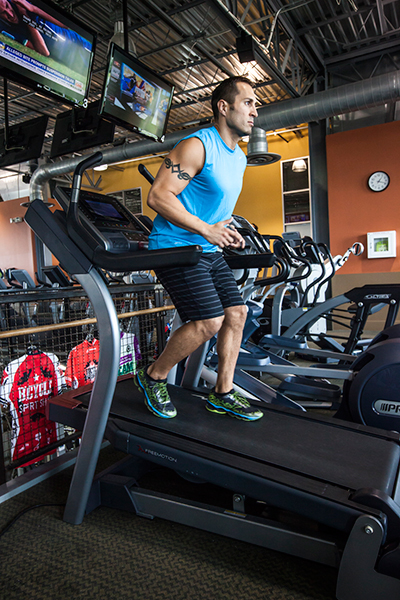Equipment Review: Battle Ropes and More
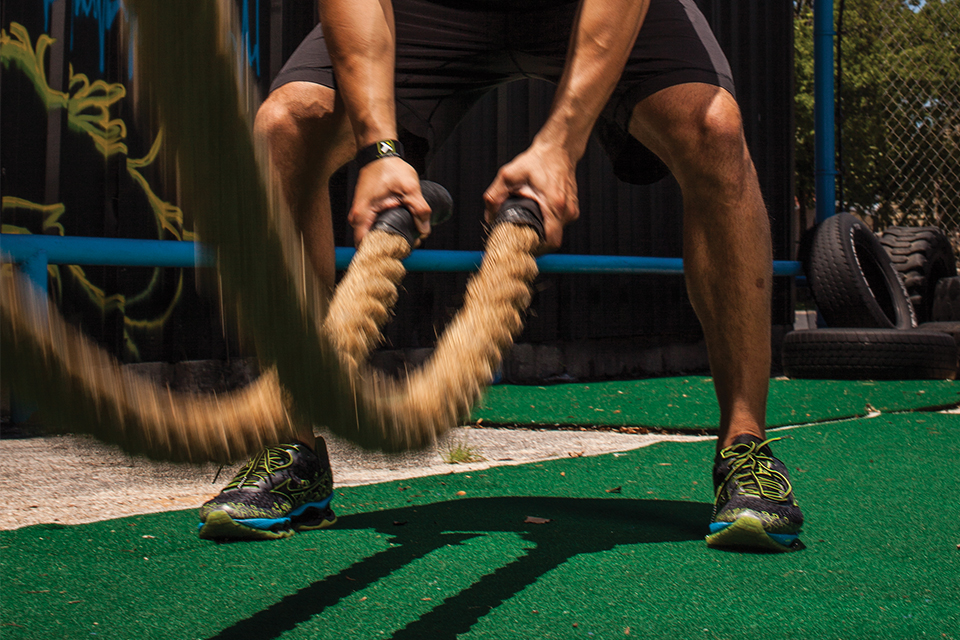
Now let’s be honest here; trips to a local Austin gym or health club can be quite an adventure. These experiences can often bring intimidation when considering new equipment and having no idea where to start with it. On the flipside, you may stumble upon a current exercise or workout approach that revolutionizes your fitness outlook.
Today’s fitness devices present themselves in diverse forms. This can be a detractor to some that may not be familiar with current fitness equipment, while for others the wait for the latest fitness equipment brings a feeling of excitement similar to that of a kid on Christmas morning.
For instance, many may look at battle ropes and think, “That’s not for me. It looks too barbaric.” Regardless of the reaction, whether pessimistic or optimistic, it usually starts with a feeling of curiosity. So let’s take a quick look at some often-asked about equipment, and I’ll lay out useful information on how they can take workouts to new creative heights.
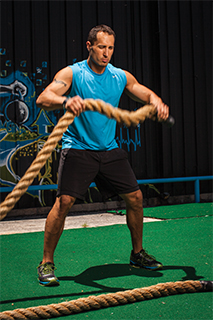 Battle Ropes
Battle Ropes
Fitness doesn’t get much more simplistic than the highly touted battle ropes. This high-powered rope has taken the elite training scene by storm, becoming popular with the military and most combat/contact (MMA, boxing, football) sports. While these ropes do not exactly qualify as “cutting edge” fitness equipment, there’s a reason why this tried-and-true training choice is still around: delivered results.
Battle ropes were developed to improve grip strength but have risen in popularity due to their many other benefits. Training and exercise have come full circle over the last few years; power movements have made a comeback on the fitness scene with CrossFit and kettlebell training at the top of this resurgence of power-based training methods. Not far from these familiar fitness styles is where you’ll find battle rope training.
Battle ropes vary in size and width. They come in 50- to 100-foot options with widths ranging from one to two inches. The longer and heavier the rope, the higher the difficulty. Beginners might want to start with an easier (shorter/thinner) rope option.
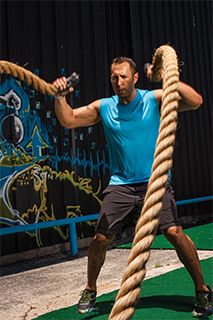 Rope material ranges from standard manila (similar to the version climbed in gym class back in the day) to more durable nylon. Nylon is used for the heavier ropes for those high-level athletes looking for an extreme challenge.
Rope material ranges from standard manila (similar to the version climbed in gym class back in the day) to more durable nylon. Nylon is used for the heavier ropes for those high-level athletes looking for an extreme challenge.
One common misconception regarding battle ropes is how difficult the exercise itself can be; it can be intimidating. But take heart—you don’t have to be striving for the NFL or a UFC championship to take part in battle rope training. It truly is an exercise for everyone at all fitness levels. I incorporate this style of training with most of my weight loss clients, as it adds a new dimension in fat burning techniques. However, those with severe back issues or shoulder impingements should pass on this form of training as it may do more damage than good
With a variety of “slams” as its foundational movement, this power-driven method of training will take endurance and mental fortitude to their limits. This intense style engages the upper body and mid-section muscles. During work sets, the arms, back, and shoulders are heavily targeted, while the core region assists in torso stabilization.This would also be considered more of an isometric conditioning movement because the sets can be lengthy. A bout of 30 seconds can seem like an eternity when giving an all-out effort.
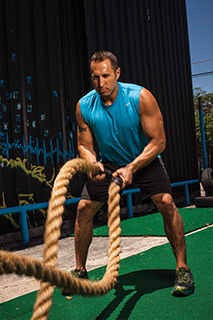 One of the great outcomes from training often with the battle ropes is the increased anaerobic (muscular) conditioning; think of it as wind sprints for the arms. If weight loss is a target, conditioning with the battle ropes is a great way to burn loads of fat while using an unconventional approach. How? The cardiovascular system is working to exhaustion during a steady 10–15 minute battle rope session, similar to completing a pressing two-mile run. I use the battle ropes for an upper body resistance training warm-up or a quick cardio bout when I am short on time. I find it difficult to take on a rope training workout for longer than 15 minutes with an all-out effort. I advise using the battle ropes as an option during a metabolic circuit because it fits in well as a quick and convenient exercise.
One of the great outcomes from training often with the battle ropes is the increased anaerobic (muscular) conditioning; think of it as wind sprints for the arms. If weight loss is a target, conditioning with the battle ropes is a great way to burn loads of fat while using an unconventional approach. How? The cardiovascular system is working to exhaustion during a steady 10–15 minute battle rope session, similar to completing a pressing two-mile run. I use the battle ropes for an upper body resistance training warm-up or a quick cardio bout when I am short on time. I find it difficult to take on a rope training workout for longer than 15 minutes with an all-out effort. I advise using the battle ropes as an option during a metabolic circuit because it fits in well as a quick and convenient exercise.
Battle ropes can also serve as a dynamic exercise alternative during resistance workouts to keep the heart rate up and maximize calorie burn. It is difficult to give any negative feedback regarding the battle ropes when the benefits are so vast. The few cautions I would offer are to ease them into work sets with a progressive intensity; don’t even think about using them if you any major shoulder problems. Assuming that’s not the case, you’re ready for battle.
If you’re into power-style training or searching for a different form of cardio to tone up for the summer, battle ropes might be for you.
Pros:
• Easy setup and storage
• Great for weight loss and performance enhancement programs
• Effective cardio option for those with lower body injuries
• Simple movement patterns
Cons:
▪ Can be pricey ($100–$200)
▪ Unique (long and open) space requirements
▪ Can be painstaking on forearms and shoulders for those with weaknesses in this area
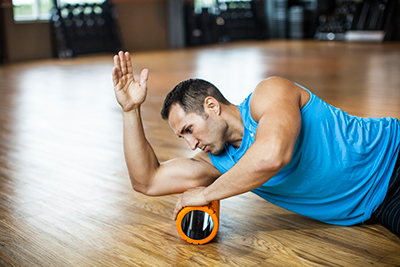 The Grid Foam Roller
The Grid Foam Roller
When I started my career as a personal trainer in 2004, I vividly remember walking into work on one of my first days and seeing half the trainers digging into their clients with instruments that simulated large rolling pins. Curiosity piqued, I nearly tumbled down a short set of stairs trying to watch what they were doing. What I saw appeared to be more along the lines of a deep tissue massage due to the grimaces and array of facial expressions the clients were wearing; I couldn’t help but think that these trainers were taking “no pain, no gain” to whole other level. As a personal training newbie not yet tuned into the science aspect of the career I would come to love so much, it took me some time to learn the value of self myofascial release (SMR).
SMR is a technique used to relieve muscle pain and tension that may result from physical and physiological stressors. In extreme cases, these areas (also known as trigger points) can become irritated to the level of severe pain. Common areas on the body targeted for pain relief include the front, back, and side regions of the thighs, along with the surrounding hip region and lower leg muscles (calves).
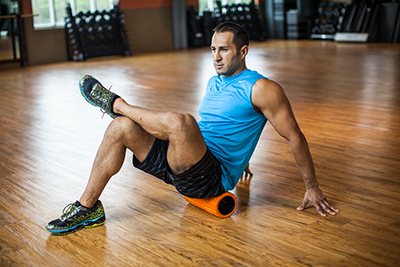 A great maintenance tool for the physically active, SMR can also provide relief for those who are not as often engaged in physical activities. Believe it or not, muscle tissue can be the cause of a great deal of pain if it isn’t utilized it. Folks who spend most of the day sedentary at work sitting at a desk may find this technique can offer many physical benefits. SMR is a great way to alleviate aches and pains caused by tension and can be invaluable in relieving daily pains caused by inactivity and bad posture. It is recommended that highly active individuals use SMR as a part of their warm-up routines, which initiates blood flow to the muscles. After a rigorous training session, a post-workout application is also advised to initiate the healing process within the muscles.
A great maintenance tool for the physically active, SMR can also provide relief for those who are not as often engaged in physical activities. Believe it or not, muscle tissue can be the cause of a great deal of pain if it isn’t utilized it. Folks who spend most of the day sedentary at work sitting at a desk may find this technique can offer many physical benefits. SMR is a great way to alleviate aches and pains caused by tension and can be invaluable in relieving daily pains caused by inactivity and bad posture. It is recommended that highly active individuals use SMR as a part of their warm-up routines, which initiates blood flow to the muscles. After a rigorous training session, a post-workout application is also advised to initiate the healing process within the muscles.
SMR rolling techniques are a very effective therapeutic modality and should be a staple in any muscular maintenance program. Rollers come in a variety of surface densities to provide relief; this density also determines the intensity levels. A firm surface provides a more aggressive application while a softer shell takes on the muscle with a bit more ease; the latter version is highly recommended for those new to the SMR technique. Beginners should go with a modest approach to get a feel for SMR (so to speak) while preventing any unwanted pressure on the muscles. A small amount of discomfort is OK, as some trigger point areas are a bit more sensitive to pressure.
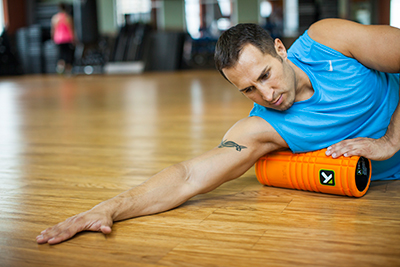 The good news is that there are now hybrid rollers that take on both firm and soft characteristics for a nice mix. A current notable product is the Trigger Point Grid that consists of a PVC pipe-ish core material covered by a unique foam surface. I use the Grid regularly and find that it is the perfect transition piece to a higher intensity level of SMR without taking the leap of faith in using PVC pipe alone (I must admit that, even as a personal trainer, the thought of taking a rock-hard plastic pipe to my aching muscles makes me cringe.) That option is a more extreme version of SMR and should be approached with thoughtful caution.
The good news is that there are now hybrid rollers that take on both firm and soft characteristics for a nice mix. A current notable product is the Trigger Point Grid that consists of a PVC pipe-ish core material covered by a unique foam surface. I use the Grid regularly and find that it is the perfect transition piece to a higher intensity level of SMR without taking the leap of faith in using PVC pipe alone (I must admit that, even as a personal trainer, the thought of taking a rock-hard plastic pipe to my aching muscles makes me cringe.) That option is a more extreme version of SMR and should be approached with thoughtful caution.
Trigger Point hits the spot with a therapy product that stands out as a progressive surface blend. The Grid Roller has a unique ethylene vinyl acetate foam surface to cover the hard core, giving it a near-flawless combination of firmness. This Grid Roller also includes an interesting surface technology that has a distinct design—it acts like human fingers and palms, simulating the traditional hand massage. These grid rollers also come in an array of sizes. A few of the size options easily fit into a gym bag without taking up too much space. While the larger sizes are not so travel friendly, the trade-off is that they provide more surface area to use.
There are quite a few options for SMR techniques out there, but I feel the easiest and least expensive route is to go with the foam roller. It is very easy to learn the proper techniques to do it, making it a hospitable option to all fitness levels.
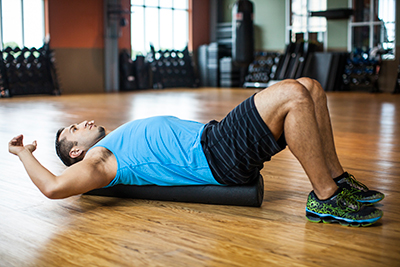 I know what you’re thinking—I’ll just get a massage! It’s true that massages are fantastic and can do wonders for the mind and body, but let’s face it; they can be pretty pricey, especially if you want to indulge on a regular basis. Some argue that the SMR rolling technique does give you similar outcomes to that of a deep tissue massage. Regardless of preference, I highly recommend that active people add SMR to their routines. Be mindful that, while this technique is fairly easy to pick up, there can still be some challenges. Research different sizes and types of foam rollers; enlist professional help. A personal trainer can set up several different types to try. And if you already have a personal trainer, consult with him or her about this technique to find out if it’s the best route for you.
I know what you’re thinking—I’ll just get a massage! It’s true that massages are fantastic and can do wonders for the mind and body, but let’s face it; they can be pretty pricey, especially if you want to indulge on a regular basis. Some argue that the SMR rolling technique does give you similar outcomes to that of a deep tissue massage. Regardless of preference, I highly recommend that active people add SMR to their routines. Be mindful that, while this technique is fairly easy to pick up, there can still be some challenges. Research different sizes and types of foam rollers; enlist professional help. A personal trainer can set up several different types to try. And if you already have a personal trainer, consult with him or her about this technique to find out if it’s the best route for you.
While I feel the Grid Roller is a high-caliber option for your next SMR experience, the standard foam roller is always a good plan B. So if you are looking for that bittersweet deep tissue muscle relief, take one of these foam rollers for a spin and show your body some love.
Pros:
• Great for muscular health and maintenance
• Convenient sizes for gym or travel use
• User friendly application
• Comparable to a massage; great option to save $$$ in the long run
Cons:
• Can be a bit uncomfortable with certain trigger point areas of the body
• Trigger Point products can be on the pricier side
• Can be a bit rough on the shoulders with certain application areas
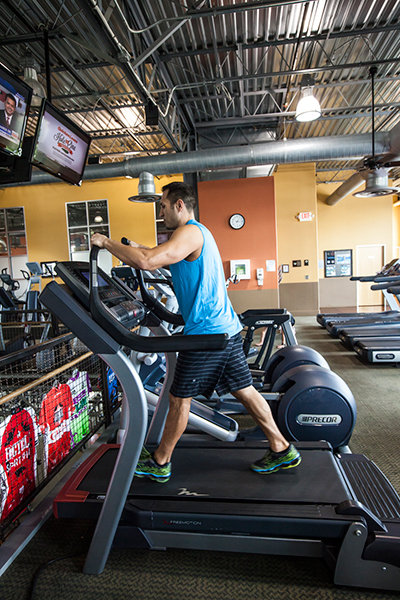 FreeMotion Incline Trainer
FreeMotion Incline Trainer
If you’ve participated in any of the various running events here in Austin, chances are you’ve scaled a few lofty hills at some point…. and felt your heart rate shoot through the roof in the process.
Whether you prefer hiking, sprinting, or methodically jogging up inclines, these vertical feats always make for a tough challenge. They are, by far, one of the most effective methods to getting in shape, depending on your approach—you must keenly manage your level of exertion throughout the workout sessions. Heart rates can skyrocket during hill workouts, so be mindful of your intensity and rest as needed. You can prepare by increasing the incline levels during cardio sessions to take workouts to challenging new heights.
With this hill training approach in mind, FreeMotion brought the experience of incline training to the table with their rendition of a wild 30-degree incline treadmill. For those who may not be familiar with incline training, just imagine having the ability to run or walk up a fairly steep mountain while indoors. Yes, you are giving up the outdoor scenery for a gym setting but you have a better opportunity to get in shape with this convenient option.
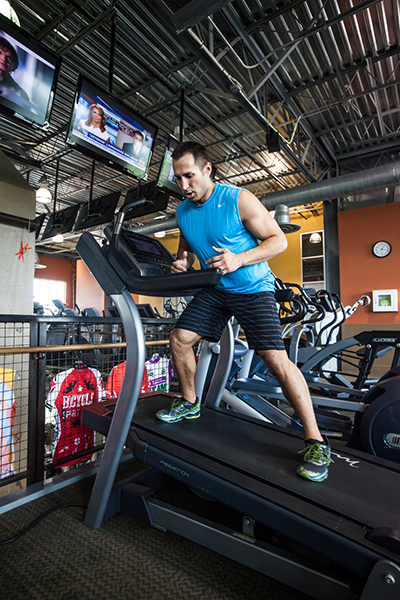
During the past few years, incline training has established itself in many fitness clubs as a low-impact, fat-torching cardio machine. Many health experts claim that incline training offers an array of health benefits along with the capacity to significantly enhance weight loss programs. This recent FreeMotion creation has also become one of the high-end incline training systems available today. It’s a versatile treadmill that presents users with many options, from simulating decline runs to highly difficult incline degrees of climbing or running. Another valuable attribute is its ability to encourage strengthening and rehabbing from lower body injuries.
I typically jump on the incline trainer for fat loss cardio workouts, along with rehabbing and strengthening my lower body. The higher incline levels encourage quad, hamstring, and glute activation, making it comparable to a leg workout. Find a challenging incline level (16–21 degrees) and moderate speed (2–4 mph) and you will experience a high (fat) calorie burn workout with minimal force on ailing knees and back. When you rise above the 21-degree incline mark, the workout takes an intense turn. Tackling the next incline range of 21–30 degrees will quickly heighten your cardiovascular output, similar to that of running. At this point, your leg muscles begin to fully kick in, sending your fat burning potential through the roof. The incline trainer has proved to be very user-friendly to all age groups and fitness backgrounds. Also, while it is a rather easy machine to use, there are always cautions to take into account with any heavy fitness machinery.
This incline trainer easily fulfills its steep promise of keeping you at the top of your cardio fitness. If you’re looking for a way to enhance your weight loss goals or “practice” those hills before the next running event, this incline trainer will, without a doubt, bring out your peak performance.
Pros:
• An outstanding way to burn fat calories as a low impact activity
• Great indoor option for athletes looking to improve leg power and endurance
• Extraordinary incline capabilities
• Fairly easy operating display; simple controls; welcoming to all fitness levels
• Very sturdy and quiet cardio unit
Cons:
• Hefty price tag
• Some mechanical issues reported
• Large machine; occupies a lot of space
